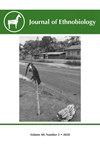From Black Magic to Black Flags: Social Uses and Symbolic Lexicons of Cycads in Vanuatu
IF 1.3
3区 社会学
Q1 ANTHROPOLOGY
引用次数: 0
Abstract
The paper reviews nondietary uses and symbolic connotations of cycads ( Cycas seemannii) in Vanuatu, relying on data from ethnographic studies, anthropological literature, and local media reports. The authors focus on the uses of cycads in magical practices, in grade-taking ceremonies and traditional land tenure, in reconciliation and peace-making, in tabooing and emblematization of chiefly authority, and in the symbolism of political movements and state institutions. The article suggests two potential genealogies of cycad prominence in the archipelago, one stemming from the role of the plant as an emblem of pacificatory influence of graded societies and the other centered on the use of cycad leaves as tallies for recalling debts in traditional ni-Vanuatu culture.从黑魔法到黑旗:瓦努阿图苏铁的社会用途和符号词汇
本文根据民族志研究、人类学文献和当地媒体报道的数据,回顾了瓦努阿图苏铁(Cycas seemannii)的非饮食用途和象征意义。作者将重点放在苏铁在魔法实践、升学仪式和传统土地占有、和解与和平、主要权威的禁忌和象征、政治运动和国家机构的象征等方面的应用上。文章提出了苏铁在群岛中突出的两种潜在谱系,一种源于该植物作为等级社会的和平影响的象征的作用,另一种源于苏铁叶子在传统的尼瓦努阿图文化中作为追讨债务的计数。
本文章由计算机程序翻译,如有差异,请以英文原文为准。
求助全文
约1分钟内获得全文
求助全文
来源期刊

Journal of Ethnobiology
Social Sciences-Anthropology
CiteScore
4.80
自引率
3.40%
发文量
21
审稿时长
>12 weeks
期刊介绍:
JoE’s readership is as wide and diverse as ethnobiology itself, with readers spanning from both the natural and social sciences. Not surprisingly, a glance at the papers published in the Journal reveals the depth and breadth of topics, extending from studies in archaeology and the origins of agriculture, to folk classification systems, to food composition, plants, birds, mammals, fungi and everything in between.
Research areas published in JoE include but are not limited to neo- and paleo-ethnobiology, zooarchaeology, ethnobotany, ethnozoology, ethnopharmacology, ethnoecology, linguistic ethnobiology, human paleoecology, and many other related fields of study within anthropology and biology, such as taxonomy, conservation biology, ethnography, political ecology, and cognitive and cultural anthropology.
JoE does not limit itself to a single perspective, approach or discipline, but seeks to represent the full spectrum and wide diversity of the field of ethnobiology, including cognitive, symbolic, linguistic, ecological, and economic aspects of human interactions with our living world. Articles that significantly advance ethnobiological theory and/or methodology are particularly welcome, as well as studies bridging across disciplines and knowledge systems. JoE does not publish uncontextualized data such as species lists; appropriate submissions must elaborate on the ethnobiological context of findings.
 求助内容:
求助内容: 应助结果提醒方式:
应助结果提醒方式:


